Figure 4.
Histamine (HA) distribution in embryonic and post-embryonic stages of the sea urchinS. purpuratus. Panels A-F show larval stages with increasing age. Nonspecific staining is seen in the stomach (St) in panels A-D. A) 4 arm pluteus larva that shows the developing lateral arm cluster (LAC) at the base of the post-oral arms (POA; indicated by arrows). These cells project into the arms where histaminergic cells are visible in the region of the larval skeletons. HA is also detected in ciliated band cells (CBC) along the larval arms. B) At the 6 arm stage, the lateral cell clusters (LAC) have grown in size and extensive projections into both the anterior and posterior parts of the larva have developed. We also noticed an increase of histaminergic cells in the region of the larval skeletons and the CBC. Unknown cell types (UC) in the leftmost arm and the epaulette (Ep) also show some histaminergic immunoreactivity. Projections into the larval arms can be well seen in panels C and D) At metamorphic competence, a second cluster of histaminergic cells has developed in the region of the apical organ (AO). Extensive projections are now established in all parts of the larva. In addition, two large histaminergic cells were identified in the aboral arms (ALC). These cells are shown at a higher magnification in E. F) shows a different perspective of a competent larva, emphasizing the developing juvenile rudiment. Two main cell types appear to be histaminergic: the epineural folds (Ef) and the epidermis of the tube feet (Tf). The white arrow also depicts the histaminergic cells in the apical organ (AO). Scale bars:A - 75 μm; B - 90 μm; C - 90 μm; F - 150 μm; D - 150 μm; E - 50 μm.

